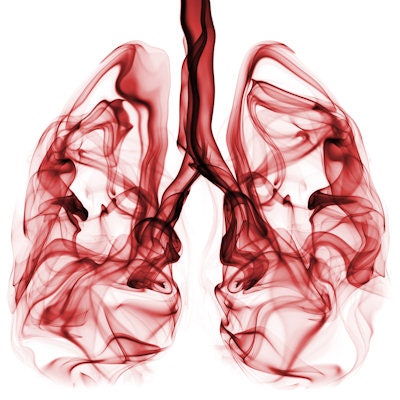
What's the best way to personalize CT lung cancer screening to make sure it has the greatest positive effect? A group from Michigan came up with three factors to consider, ranging from lung cancer risk to life expectancy, in a paper published online May 29 in the Annals of Internal Medicine.
The researchers performed a simulation using data from the National Lung Screening Trial (NLST) and found that screening benefited most eligible patients with a high risk of cancer, even if they held a negative view of the test. However, having a preference against screening lowered the quality-adjusted life year (QALY) measure of patients with either a low risk (< 0.3%) of developing cancer or a relatively short life expectancy of less than 10.5 years (Ann Intern Med, May 29, 2018).
"Our results support the importance of personalizing the harm-benefit assessment of CT lung cancer screening for informing screening decisions rather than uniformly recommending or withholding a recommendation for eligible patients," wrote first author Dr. Tanner Caverly and colleagues from the University of Michigan Medical School.
Patient preference
Several factors can complicate the implementation of CT lung cancer screening into a radiology facility's clinical practice, including the variability in absolute risk reduction for eligible individuals, potential harms and costs associated with screening, surgical risk, and patients' priorities, according to the authors. These and other causes have fueled uncertainty and even controversy regarding who the best candidates for screening are, as well as the most effective way to promote screening to eligible individuals.
 Dr. Tanner Caverly from the University of Michigan.
Dr. Tanner Caverly from the University of Michigan.Prior research has shown that using risk-based eligibility criteria for lung cancer screening could help avert more deaths than using current guidelines from the U.S. Preventive Services Task Force (USPSTF). But there are also proponents of screening who believe that the more comprehensive USPSTF guidelines may help clinicians prevent as many deaths from lung cancer as possible.
Whether a clinician is a proponent of one camp or the other, there is room to factor in patient preference, Dr. Michael Gould of Kaiser Permanente Southern California wrote in an accompanying editorial.
"Persons at one end of the spectrum prefer to avoid death from lung cancer at any cost, whereas those at the other end want to avoid unnecessary worry, tests, and treatments," he wrote. "But how do we help the majority of patients in the middle to make a decision about screening that is informed not only by evidence but also by their preferences?"
Moving beyond the optimization of screening eligibility criteria, Caverly and colleagues sought a way to assist clinicians in presenting the pros and cons of screening to eligible individuals. To that end, they developed a microsimulation model based on data from the NLST to determine the effect of patient preference on the net benefit of three rounds of annual screening.
The researchers specifically observed the influence on patient outcome of "disutilities," or negative feelings toward CT lung cancer screening due to inconveniences or complications. To quantify this disutility, they subtracted different amounts of time from each patient's QALY based on the preference for screening.
For example, they reduced the QALY of patients who underwent screening with a favorable attitude toward the test by only 0.0365 days to account for potential issues associated with screening in general. On the other hand, patients who had a negative attitude toward the test had a larger reduction of 3.65 days.
Variation in health gains
Using the model, the group found that there was a 22.7% relative risk reduction in lung cancer mortality for patients who underwent a series of three CT screening exams, compared with those who did not partake in screening at all. The model's estimates for lung cancer incidence, mortality, and stage distributions corresponded with observed data in the NLST.
On average, screening led to 2,700 QALYs gained per 100,000 individuals. The number of QALYs gained was only 830 per 100,000 individuals who had a lower risk (< 0.3%) of lung cancer, but it rose to 3,500 for those at high risk (0.3% to 1.3%). What's more, the QALY gains were considerably lower for patients with a life expectancy of less than 10.5 years, whereas QALY gains improved for patients with a life expectancy of at least 10.5 years.
In terms of patient preference, the investigators reported that for the 52.9% of patients who had a relatively high cancer risk (≥ 0.3%) and life expectancy (≥ 10.5 years), there was a net positive QALY benefit, regardless of their preference for screening. This trend was true even when factoring in a false-positive rate of up to 60% and an overdiagnosis rate of up to 15%. However, for the 47% of patients who had low cancer risk (< 0.3%) or a life expectancy of less than 10.5 years, having an unfavorable preference toward screening led to a net loss in QALY measures.
| Effect of patient preference for CT lung cancer screening on QALY gains | ||
| Lung cancer risk | Unfavorable preference | Favorable preference |
| Low (< 0.3%) | Net harm | Net benefit |
| High (0.3% to 1%) | Net benefit | Net benefit |
"Our results suggest that for some high-risk, high-benefit patients ... lung cancer screening could generally be recommended during shared decision-making," the authors wrote. "For such patients, the absolute mortality benefit of CT screening is on par with that of average-risk colon cancer screening ... and is considerably more effective than screening mammography."
Rules of thumb
The findings from the model are most relevant for those interested in taking a nuanced, patient-centered approach to discussing CT lung cancer screening, according to the authors.
For these parties, Caverly and colleagues offered a few rules of thumb when personalizing CT lung cancer screening:
- Screening may provide the most benefit to patients with an annual lung cancer risk between 0.3% and 1.3%.
- Screening may be sensitive to patient preference, if the patient has a lung cancer risk of less than 0.3%, a risk of more than 1.3% due to limited life expectancy, or a life expectancy of less than 10.5 years.
- Screening may have negligible benefit or even net harm for patients both at low risk and with a short life expectancy.
The investigators have also created an online decision tool that incorporates these rules to facilitate discussions concerning personalized CT lung cancer screening.
They acknowledged several limitations of the study, including the existence of multiple risk-prediction models, each of which differs from the Bach model they used. These prediction models take into account different factors when estimating lung cancer risk, which can lead to variability in risk classification. In addition, the simulation model only examined the effect of three annual screening rounds; the cumulative benefit of longer screening periods could alter the results.
"Going forward, the debate over whom to screen will continue, although it might be framed more appropriately as 'whom to offer screening,' " Gould wrote. "Screening most efficiently, most inclusively, or most consistently with the underlying evidence are viable approaches to precision lung cancer screening. In each case, targeted assessment of patient preferences may be the next step."




















